I‘am Dr. Robert Kuechler, Managing Director of a company that manufactures high-precision miniature capacitance dilatometer and scientist at the Max-Planck Institute for Chemical Physics of Solids in Germany.

The world´s smallest capacitive dilatometer, for high-resolution thermal expansion and magnetostriction in high magnetic fields.
Articles:
Rev. Sci. Instrum. 94, 045108 (2023)
Rev. Sci. Instrum. 88, 083903 (2017)

The world’s smallest stress-implementing high-precision capacitance dilatometer
Article: Rev. Sci. Instrum. 94, 045108 (2023)

A compact and miniaturized high resolution capacitance dilatometer for measuring thermal expansion and magnetostriction.
Article: Rev. Sci. Instrum. 83, 095102 (2012)

A uniaxial stress capacitive dilatometer for high-resolution thermal expansion and magnetostriction under multiextreme conditions.
Article: Rev. Sci. Instrum. 87, 073903 (2016)
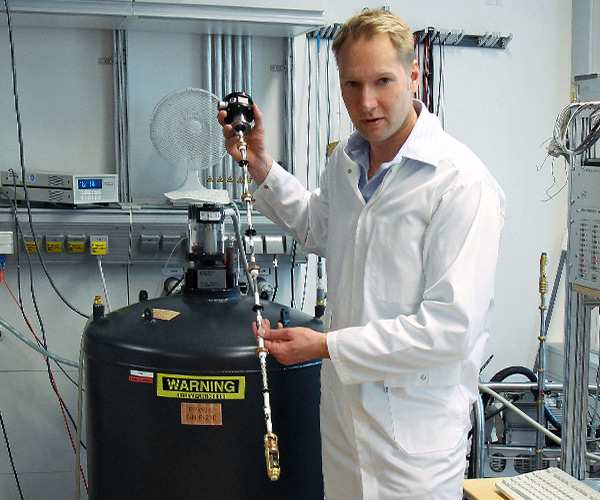
The dilatometer can be used in a wide temperature range and with several cryogenic systems down to ultra-low temperature (less than 10 mK) and in magnetic fields to at least 38 T. For the most widely used systems (such as PPMS or Kelvinox systems) we additionally offer the matching accessories for suitable mounting.
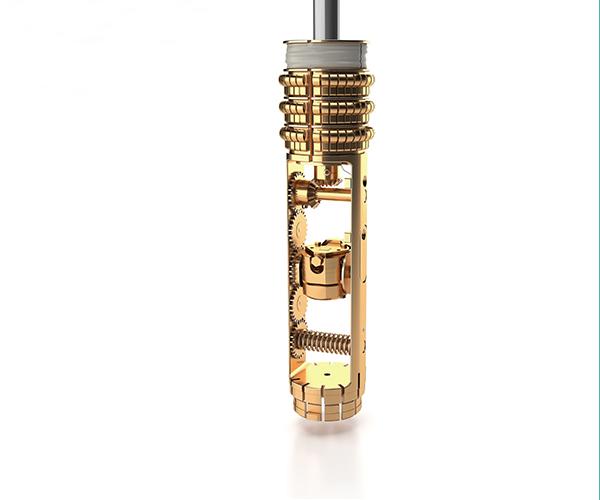
Manual In-situ rotation of the sample within the cell between -90° and +90° inside of the PPMS enables systematic anisotropy studies
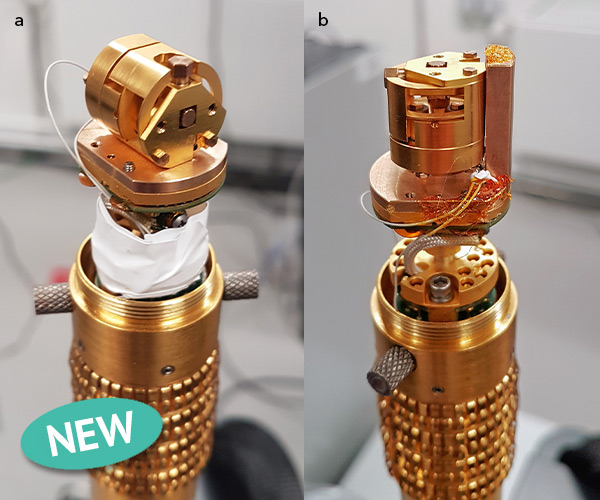
The new Setup enables measurements of thermal expansion and magnetostriction in a temperature range spanning 4 K down to 0.06 K. Both mini-dilatometers can be mounted on an adopter of the dilution refrigerator (a) perpendicular and (b) parallel to the applied field.
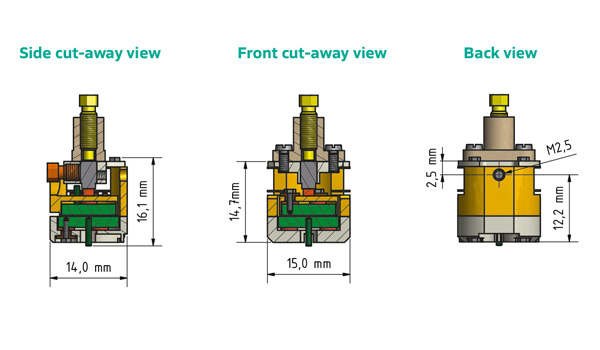
The great advantage of the new type of measuring cells is based on a unique
combination of powerful design, production technology and high level of
manufacturing quality.
Size and Dimensions
footprint: 14 mm × 15 mm; height: 16 mm; weight: 13 g
Absolute resolution
@ low Temperature (Kelvinox-Systems (0.01 K up to 6 K)): ΔL = 0.01 Å
@ PPMS ΔL = 0.01 Å
Range of operation
Temperature range: 10 mK < T < 320 K
Magnetic field range: At least up to 38 T (max. tested field)
Measurable sample size
footprint (max.): (2.3 mm × 6 mm) or Ø = 3.3 mm
height: Less than 1 mm up to 2.75 mm
Materials
Dilatometer-parts: copper beryllium
Insulating pieces; washers: vespel; sapphire
Options
+ Any Cryostat: Dilatometer + attachments
+ PPMS: Dilatometer (can be rotated) complete with PPMS-probe and cables + software
+ Dilution Refrigerator Insert for the PPMS DynaCool: complete with two adapters, aluminium flange with built-in vacuum tight Fischer connectors, coaxial cables to connect Fischer connectors with capacitance bridge, software, coaxial cables for the inside of the DR Insert are supplied, but must be installed on its own in consultation with QD.

A comparison of the mini-stress dilatometer with the almost zero pressure mini-dilatometer: Each dilatometer consists of four main parts: (A) bottom part, (B)
main body, (C) cover, and (D) sample-adjusting tool. To apply additional uniaxial stress, just the main body (B) is different and has to be exchanged. The
stress cells in the main body contain four springs with a thickness of 0.5 mm instead of two springs with a thickness of 0.25 mm. Size and Dimensions,
Absolute resolution, Range of operation, Measurable sample size and used materials are exactly the same as for the Mini-Dilatometer.
Size and Dimensions
footprint: 14 mm × 15 mm; height: 16 mm; weight: 13 g
Absolute resolution
@ low Temperature (Kelvinox-Systems (0.01 K up to 6 K)): ΔL = 0.01 Å
@ PPMS ΔL = 0.01 Å
Range of operation
Temperature range: 10 mK < T < 320 K
Magnetic field range: At least up to 38 T (max. tested field)
Applied force: from 50 up to 65 N
max. uniaxial stress: 4 kbar for cuboid sample of (0.4 mm)2 cross section
Measurable sample size
footprint (max.): (2.3 mm × 6 mm) or Ø = 3.3 mm
height: Less than 1 mm up to 2.75 mm
Materials
Dilatometer-parts: copper beryllium
Insulating pieces; washers: vespel; sapphire
Options
Any Cryostat: Dilatometer + attachments
PPMS: Dilatometer (can be rotated) complete with PPMS-probe and cables + software
Dilution Refrigerator Insert for the PPMS DynaCool: complete with adapter, cables + software, coaxial
cables for the inside of the DILUTION REFRIGERATOR INSERT are supplied, but must be installed on
its own in consultation with QD.
Innovative patent-pending production method allows for an unprecedented resolution in a dilatometer of this
compact size.
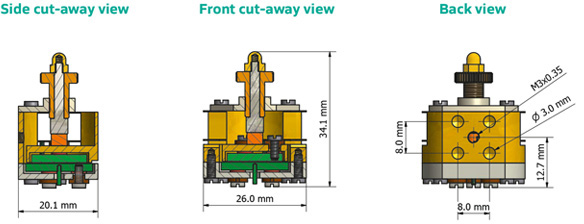
Size and Dimensions
footprin: 20 mm × 26 mm; height: 34 mm; weight 45 g
Absolute resolution
@ low Temperature (Kelvinox-Systems (0.01 K up to 6 K)): ΔL = 0.02 Å
@ PPMS ΔL = 0.01 Å
Range of operation
Temperature range: 10 mK < T < 320 K
Magnetic field range: At least up to 30 T (max. tested field)
Measurable sample size
footprint (max.): (3.5 mm × 10 mm) or Ø = 5 mm
height: Less than 1 mm up to 5 mm
Materials
Dilatometer-parts: copper beryllium
Insulating pieces; washers: vespel; sapphire
Options
Any Cryostat: Dilatometer + attachments
PPMS: Dilatometer complete with PPMS-probe and cables + software

Size and Dimensions
footprin: 20 mm × 26 mm;; height: 41 mm; weight 52 g
Absolute resolution
@ low Temperature (Kelvinox-Systems (0.01 K up to 6 K)): ΔL = 0.02 Å
@ PPMS ΔL = 0.01 Å
Range of operation
Temperature range: 10 mK < T < 320 K
Magnetic field range: At least up to 30 T (max. tested field)
Applied force: from 40 up to 75 N
max. uniaxial stress: 3 kbar for cuboid sample of (0.5 mm)2 cross section
Measurable sample size
footprint (max.): (3.5 mm × 10 mm) or Ø = 5 mm
height: Less than 1 mm up to 5 mm
Materials
Dilatometer-parts: copper beryllium
Insulating pieces; washers: vespel; sapphire
Options
Varity of Cryostats: Stress-dilatometer + attachments
PPMS: Dilatometer complete with PPMS-probe and cables + software
Thermal expansion coefficient divided by temperature α/T measured along the c- and a-axis as a function of temperature at different uniaxial stresses applied parallel to the measurement direction. The stress was stepwise increased by reducing the samples cross-section.
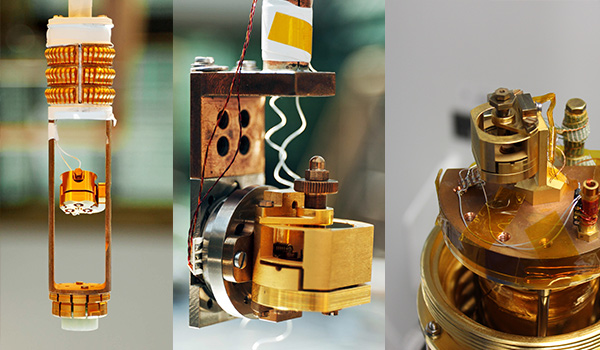
Our dilatometers can be used in a wide range of temperature. They were tested and operated down to extremely low
temperature (10 mK). The maximal operation temperature is determined by the thermal capability of the insulating
pieces of vespel and the used coaxial cables. So far, dilatometers were only tested at temperatures just above room
temperature. To achieve the best possible results the dilatometers have to be operated in a steady flowing inert
gas atmosphere, where the dielectric constant of the medium does not change with temperature (e.g. helium,
nitrogen, clean and dry air, vacuum). The operation in flow cryostats or directly in cryogenic liquids (helium) is
not recommended. Our dilatometers have been successfully operated in most commonly measurement systems,
e.g. in the Quantum Design PPMS under helium atmosphere or in an Oxford Instruments Kelvinox dilution refrigerator
under vacuum. For all these systems, we offer the matching accessories for suitable mounting.
Selected Applications
1. PPMS (Physical Property Measurement System by Quantum Design)
2. Kelvinox™ Dilution Refrigerator by Oxford Instruments
3. Exchange Gas cryostat
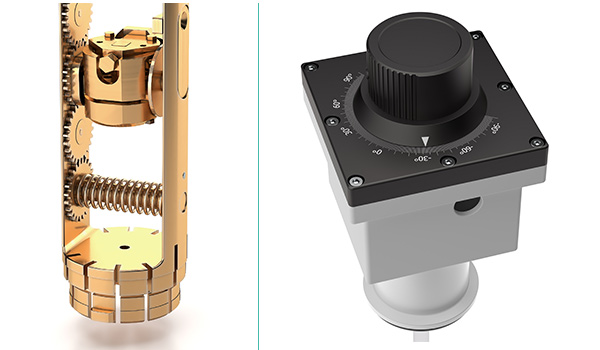
Sample Space Parameters: samples up to 2.75 mm can be measured
Operational Range: 1.8 to 350 K, 0 to 16 T
Possible Resolution: 0.01 × 10-10 m
Manual In-situ rotation (rotation axis normal to the direction of applied field) of the sample within the cell between -90° and +90° inside of the PPMS enables systematic anisotropy studies.
The change in length of a 1 mm large NbP single crystal at 2 K is shown as a function of applied magnetic field; quantum oscillations in the length change due to the de Haas-van Alphen effect can clearly be seen. The field was swept in a DynaCool System with 10 Oe/sec.
Options for PPMS and PPMS DynaCool: Mini-Dilatometer or Mini-Stress-Dilatometer (can be rotated in-situ) complete with PPMS-probe and coaxial cables to connect probe with capacitance bridge + software.
Sample Space Parameters: samples up to 2.75 mm can be measured
Operational Range: 0.06 to 4 K, 0 to 16 T
Possible Resolution: 0.01 × 10-10 m
Mini ans Mini-Stress Dilatometer can be used
Thermal expansion:
Left picture: The very sharp λ-Type anomaly at TN = 0.88 K shows the very high sensitivity of the dilatometer. The inset of right pichture demonstrates the extreme high resolution of the mini-dilatometers of ΔL = 0.01 Å when mounted on a DR-insert of PPMS DynaCool system.
Magnetostriction:
Top picture: Phase diagram of YbAlO3: Blue-, orange- and green-colored areas show the three magnetically ordered phases. Lower picture: Magnetostriction coefficient λ(B) measured on a 1.74 mm long single crystal along the c-axis at T = 0.065 K with Mini-Dilatometer in DR-insert. The magnetic fiels was applied along the α-axis.
Option for Dilution Refrigerator Insert for the PPMS DynaCool: complete with two adapters (to mount the dilatometer (a) perpendicular and (b) parallel to the applied magnetic field) + aluminium flange with built-in vacuum tight Fischer connectors + two coaxial cables to connect the Fischer connectors to the capacitance bridge + software. Miniature coaxial cables for the inside of the DR Insert are supplied, but must be installed on its own in consultation with QD.
Dr. Robert Kuechler
Frankenstraße 13
01309 Dresden (Germany)
Fon: +49 (0) 351 46 46 31 27
Fax: +49 (0) 351 46 46 31 26
E-mail: kuechler@dilatometer.info
VAT Number (USt.-IdNr.): DE285812663
Der Herausgeber übernimmt keine Haftung für Inhalte ausserhalb des Internetauftrittes von www.dilatometer.info.
Alle Elemente dieser Seite sind urheberrechtlich geschützt.
Eine Vervielfältigung jeglicher Art von Bild und Text bedarf einer schriftlichen Genehmigung durch den Herausgeber.
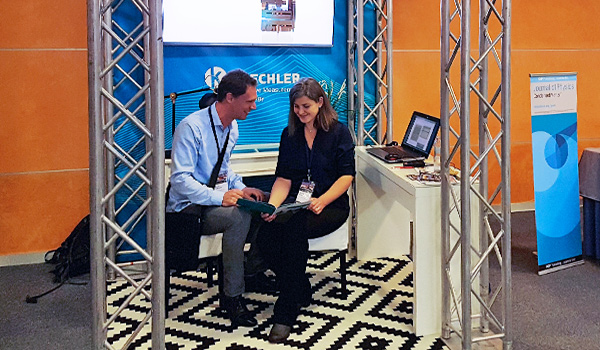
One of the organizers, Dr. Jeroen Custers and Dr. Franziska Weickert from Los Alamos National Laboratory discuss the benefits of dilatometry in Prague.

In the session "Novel techniques for SCES investigation" I introduced our patented dilatometry design and new applications in space lacking devices in my talk entitled "Ultra-high resolution capacitive dilatometry under extreme conditions"
Max Planck Institute for Chemical Physics of Solids (MPI CPFS), Germany
2002 ~ Current
One of the world’s leading experts in the field of thermal expansion and magnetostriction measurements.
2005 ~ Current
Experience of many years in the development of high resolution capacitance dilatometers for measuring thermal expansion and magnetostriction
to manufacture the today’s best High-precision miniature capacitance dilatometer (Ref: Rev.Sci.Instr.), which can be used for several applications and in a wide temperature range (300 K down to less than 10 mK). The new scientific instrument fabricated by a patent-pended technology proves its value in an increasing number of international research labs.
2012 ~ Current

Many thanks to the organizers for giving me the opportunity to give an invited talk in the session "Novel techniques for SCES investigation" at SCES 2019, from Sep. 23-28, 2019 in Okayama, Japan
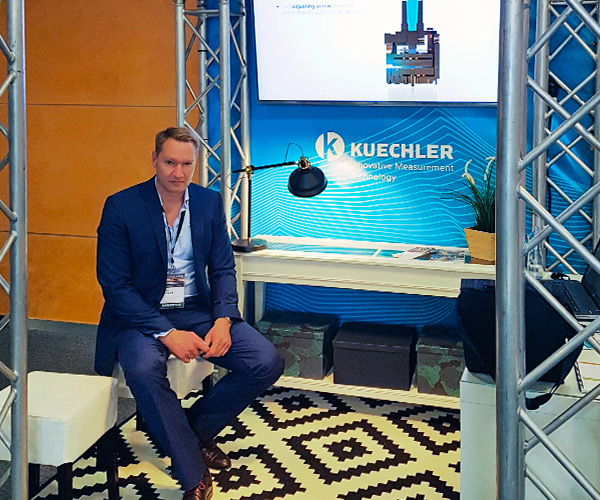
We thank the many interested visitors of our exhibition stand at the SCES 2017 Conference, from July 17 – July 21 in Prague.
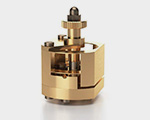
May 15, 2019

November 10, 2017
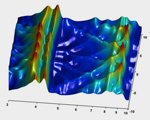
June 02, 2014
2023
Rev. Sci. Instrum. 94, 045108
Anisotropy-driven quantum criticality in an intermediate valence system
2022
Nature com. 13 (1), 2141
Possible Quadrupole Density Wave in the Superconducting Kondo Lattice CeRh2As2
2022
Phys. Rev. X 12, 122134
Field-induced transition within the superconducting state of CeRh2As2
2021
Science 373, 1012–1016
2021
Nature Com. 12, 3197
2020
Adv. Mater. 32, 20011878
Tracking Structural Phase Transitions in Lead-Halide Perovskites by Means of Thermal Expansion.
2019
Adv. Mater. 31, 1900521
Negative Thermal Expansion in the Plateau State of a Magnetically Frustrated Spinel.
2019
Phys. Rev. Lett. 123, 027205
Uniaxial stress tuning of geometrical frustration in a Kondo lattice
2017
Phys. Rev. B 96, 241110 (R)
Thermodynamic signatures of the field-induced states of graphite
2017
Nature com. 8, 1337
2017
Phys. Rev. Lett. 119, 126402
2017
Nature Physics, doi:10.1038/nphys4242
2017
Rev. Sci. Instrum. 88, 083903
Uniaxial-stress tuned large magnetic-shape-memory effect in Ni-Co-Mn-Sb
Heusler alloys
2017
Appl. Phys. Lett. 110, 071901
2016
Rev. Sci. Instrum. 87, 073903
Thermodynamic evidence for valley-dependent density of states in bulk bismuth
2014
Nature Materials 3909, 10.1038
k = 0 Magnetic Structure and Absence of Ferroelectricity in SmFeO3
2014
Phys. Rev. Lett. 113, 217203
Ferromagnetic Quantum Critical Point in the Heavy-Fermion Metal YbNi4(P1-xAsx)2
2013
Science 89, 000222
2012
Rev. Sci. Instr. 83, 095102
2012
Phys. Rev. B 85, 184408
Direct measurement of spin correlations using magnetostriction
2011
Phys. Rev. B 83, 099901
2010
J. Low Temp. Phys. 161
Kondo-Cluster-Glass State near a Ferromagnetic Quantum Phase Transition
2009
Phys. Rev. Lett. 102, 066401
Systematic study of the Grueneisen ratio near quantum critical points
2007
Sci. Tech. Adv. Mater. 8, 428
Quantum Criticality in the Cubic Heavy-Fermion System CeIn3-xSnx
2006
Phys. Rev. Lett. 96, 256403
Thermal expansion and Grüneisen ratio near quantum critical points
2006
Physica B 378, 36
Pressure effect on superconductivity in CeCoIn5-xSnx studied by thermal expansion
2006
Physica B 378, 98
2006
Physica B 378, 648
Grueneisen Ratio Divergence at the Quantum Critical Point in CeCu6-xAgx
2004
Phys. Rev. Lett. 93, 096402
Low-temperature thermal expansion and magnetostriction of YbRh2(Si1-xGex)2 (x=0 and 0.05)
2004
J. Magn. Mater. 272, 229
2004
Phys. Rev. Lett. 92, 136401
Divergence of the Grüneisen Ratio at Quantum Critical Points in Heavy Fermion Metals
2003
Phys. Rev. Lett. 91, 066405